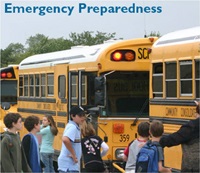Do you know the four steps to being ready?
- Make a Plan
- Build a Kit
- Stay Informed
- Know Your Neighbors

Know your area and what disasters are possible.
If you live in a flood plain, a wildland fire area or your town is on an active fault line, you need to plan accordingly.
Create a Basic Emergency Supply Kit.
Be sure that it includes the following:
- Water (have one gallon per person, per day minimum, for 3 days-for drinking and sanitation).
- Food (have a 3 day supply of nonperishable items. Canned items that require no cooking)
- Pet food & water (1 gallon per day per pet).
- Can opener (manual).
- Battery powered radio with emergency band)
- Flashlights and extra batteries.
- Moist towelettes and garbage bags (for sanitation needs).
- Local maps (if your preplanned evacuation route isn’t passable, you can navigate back roads, if necessary).
- First aid kit, disinfectant and over the counter medications.
- Whistle (to signal for help).
- Wrench or pliers (to turn off utilities).
- Dust mask, plastic sheets and duct tape to shelter in place.
- Paper towels, and disposable cups, plates and utensils.
- Cash or travelers checks, change.
- Fire extinguisher.
- Matches in a waterproof container.
Consider a few extra items, depending on your family’s needs.
These might be: extra food or treats, medication, and toys for pets; infant formula and diapers, extra eye glasses, an extra copy of your prescription slip or refill of important medications (talk to your doctor), comfortable shoes or boots and a change of clothing for each family member (remember the weather season), blankets or sleeping bags. Don’t forget small games, books, balls, etc to keep children busy.
Make a Go Bag.
Create a small version of an emergency kit with essentials like nonperishable food, water, a small first aid kit, and a change of clothes that you can grab in a hurry or keep in the car.
Know your evacuation routes.
Have more than one option for getting out of your area quickly.
Designate three family meeting spots.
Pick an area near the home to meet in the event of a fire. Choose another that is in the region, in case everyone is scattered and can’t get home. Have a third that is out of town, should your family have to evacuate separately.
Select an out-of-town contact.
Name one family member or friend who can serve as a point person if your immediate family is separated.
Make a list of phone numbers.
Everyone in the family should have a list of important contacts they carry with them. Make sure you include numbers for your office, your partner’s office, your children’s school, day care, doctors, and close family members.. Include the numbers of your health and home owner’s insurance companies, as well as your policy numbers.
Write down important personal information.
On the same emergency phone list, note any medical conditions you have. For your young children, record date of birth, address, and medical conditions. You can print out a template listing all of this info at www.ready.gov or click on the link below.
http://www.ready.gov/sites/default/files/FamEmePlan_2012.pdf
Know the emergency plan of your childrens’ schools.
If your kids are evacuated from school or day care, where do they go? Where can you pick them up?

Have a family meeting.
Make sure everyone knows and understands your emergency plan. Talk about meeting points, discuss fire safety, and have kids get involved in making the emergency supply kit. They may alert you to something you forgot-like the necessity of a spare security blanket.
Prepare for Emergencies Now